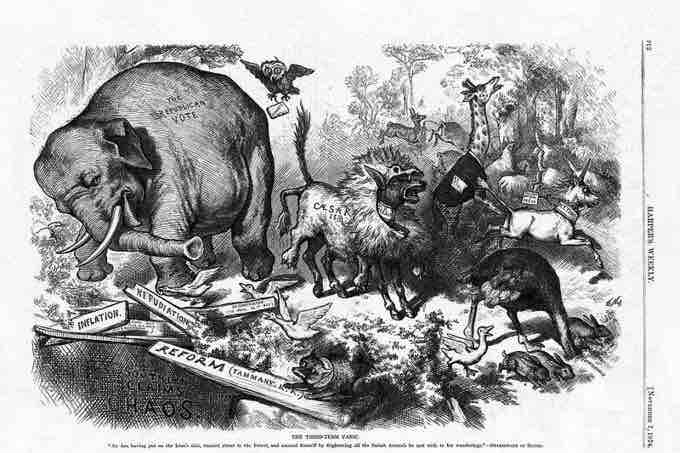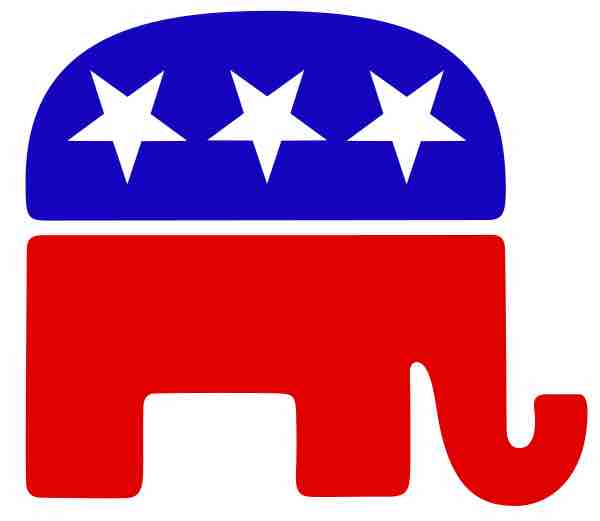Introduction
The modern political party system in the United States is a two-party system dominated by the Democratic Party and the Republican Party. These two parties have won every United States presidential election since 1852 and have controlled the United States Congress since at least 1856. Third parties have achieved relatively minor representation at national and state levels. Among the two major parties, the Democratic Party generally positions itself as left-of-center in American politics and supports a modern liberal platform, while the Republican Party generally positions itself as right-of-center and supports a conservative platform.

National Republican Elephant
"The Third-Term Panic" by Thomas Nast, originally published in Harper's Magazine 7 November 1874.

Democratic Party Logo
Logo of the Democratic Party of the United States. Light blue D inside a darker blue circle.
Many minor or third political parties appear from time to time. They serve as means to advocate policies that the two major political parties eventually adopt. At various times, the Socialist Party, the Farmer-Labor Party and the Populist Party had considerable local strength, and then faded away. Some exceptions exist, like Minnesota's Farmer–Labor Party merging into the state's Democratic Party. At present, the Libertarian Party is the most successful third party. New York State has a number of additional third parties that sometimes run their own candidates for office or nominate the nominees of the two main parties. In the District of Columbia, the D.C. Statehood Party has served as a strong third party behind the Democratic Party and Republican Party.
Organization of American political parties
American political parties are more loosely organized than those in other countries. The two major parties, in particular, have no formal organization at the national level that controls membership, activities, or policy positions. Thus, for an American to say that he or she is a member of the Democratic or Republican party is quite different from a Briton stating that he or she is a member of the Conservative or Labour party.
In the United States, one can often become a "member" of a party merely by stating that fact. Such participation does not restrict one's choices in any way. It also does not give a person any particular rights or obligations within the party, other than possibly allowing that person to vote in that party's primary elections. A person may choose to attend meetings of one local party committee one day and another party committee the next day. The sole factor that brings one "closer to the action" is the quantity and quality of participation in party activities.
Party Identification
Party identification becomes somewhat formalized when a person runs for partisan office. In most states, this means declaring oneself a candidate for the nomination of a particular party and intent to enter that party's primary election. A party committee may choose to endorse one or another of those seeking the nomination, but in the end the choice is up to those who choose to vote in the primary.
The result is that American political parties have weak central organizations and little central ideology. A party cannot prevent a person who disagrees with the majority of positions of the party or actively works against the party's aims from claiming party membership , so long as the voters who choose to vote in the primary elections elect that person. Once in office, an elected official may change parties simply by declaring such intent.
Both parties have stopped being engines for voter mobilization, however. Fewer and fewer Americans identify with one another party, preferring instead to be known as "independent" voters. For example, a 2011 USA Today review of state voter rolls indicates that registered Democrats declined in 25 of 28 states. Democrats were still the largest political party with more than 42 million voters (compared with 30 million Republicans and 24 million independents). But in 2011 Democrats numbers shrank 800,000, and from 2008 they were down by 1.7 million, or 3.9%
Party Committees
At the federal level, each of the two major parties has a national committee that acts as the hub for fundraising and campaign activities. The exact composition of these committees is different for each party, but they are made up primarily of representatives from state parties and affiliated organizations. However, the national committees do not have the power to direct the activities of members of the party .

Political parties
The symbol of the Republican Party in the U.S.
Both parties also have separate campaign committees which work to elect candidates at a specific level. The most significant of these are the Hill committees; the common name for the political party committees that work to elect members of their own party to United States Congress ("Hill" refers to Capitol Hill, where the seat of Congress, the Capitol, is located, ). The four major committees are part of the Democratic and Republican parties and each work to help members of their party get elected to each house.

Aerial View of Capitol Hill
Aerial view of Capitol Hill showing the Capitol, Supreme Court Building, Library of Congress, and congressional office buildings.